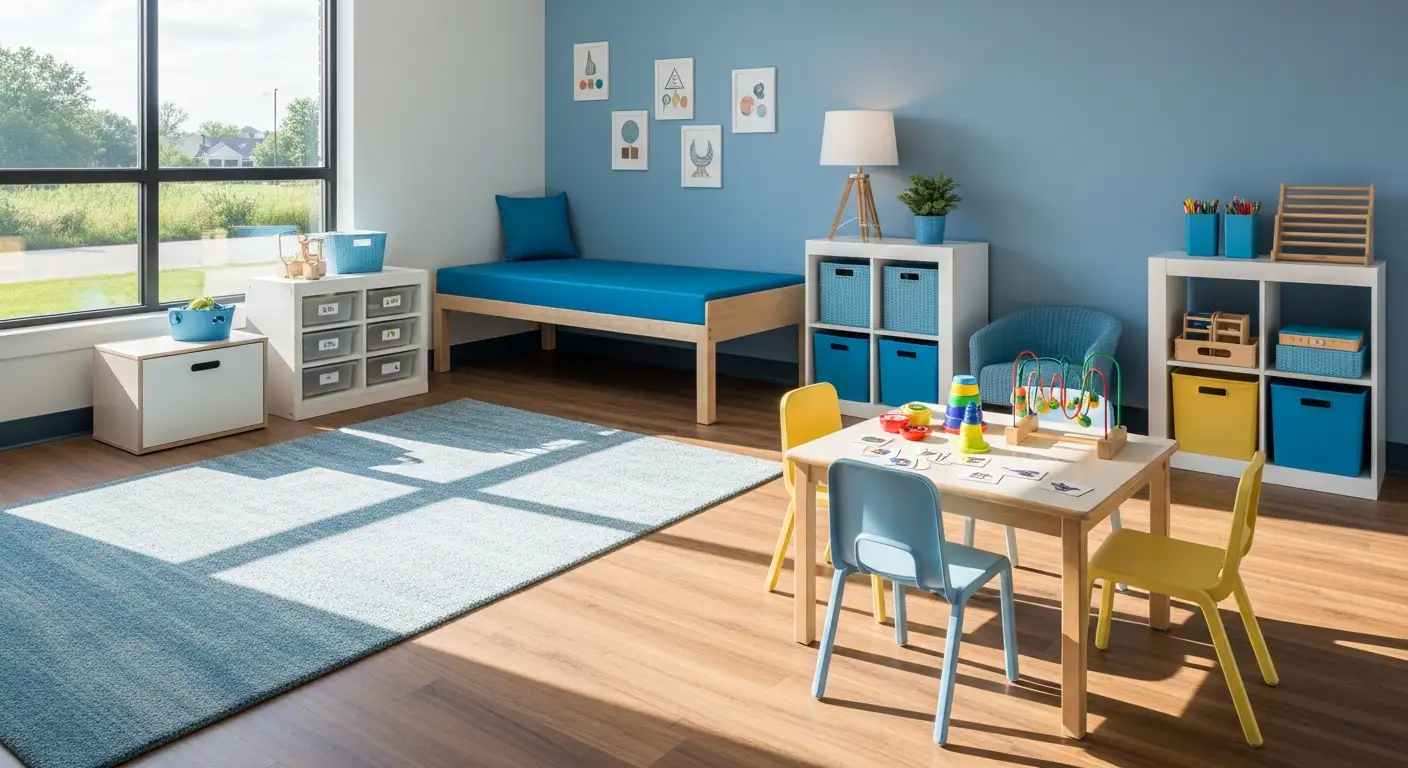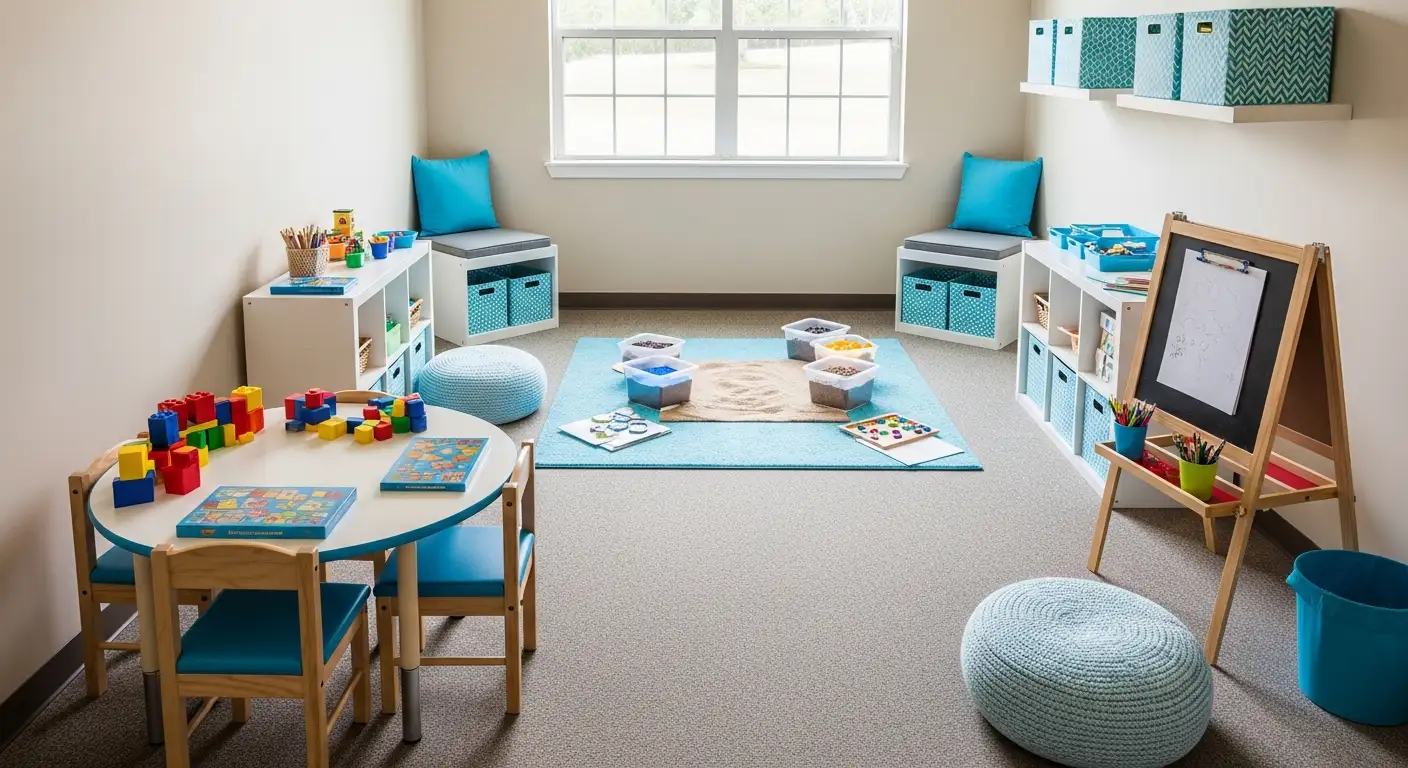The Importance of Developing Communication Skills in Children with ASD

Understanding the Significance of Communication Development
Developing communication skills in children with Autism Spectrum Disorder (ASD) is pivotal not only for their personal expression but also for their educational and social development. For children on the autism spectrum, effective communication can open doors to learning, social connection, and emotional understanding. By recognizing and addressing the unique communication needs of each child, parents, educators, and healthcare providers can lay the groundwork for more meaningful interactions and improved quality of life.
Why Communication Skills Matter for Autistic Children

Importance of Communication Skills
Communication skills are crucial for autistic children's development. They enable children to learn, connect with others, and effectively express their thoughts and feelings. Without strong communication abilities, autistic children may struggle in social contexts, impacting their overall quality of life.
Unique Language Patterns in Autism Spectrum Disorder
Children with Autism Spectrum Disorder (ASD) often display unique language patterns. Some may engage in echolalia, repeating phrases without understanding their meaning. Others might show delays in expressive language. This variability highlights the need for tailored approaches to support their communication styles, whether through verbal means or non-verbal expressions such as gestures.
Role of Augmentative and Alternative Communication Systems
Augmentative and Alternative Communication (AAC) systems play a vital role in supporting communication for children with ASD. Tools like communication boards, Picture Exchange Communication System (PECS), and speech-generating devices empower non-verbal children to express needs effectively. These systems facilitate meaningful interaction, reduce frustration, and lay the groundwork for developing oral language skills over time.
To foster communication skills, understanding each child's unique abilities and challenges is key. Incorporating engaging activities and allowing for play-based interactions can encourage children to practice their communication in effective ways.
Challenges Faced by Children with ASD

What challenges do children with Autism Spectrum Disorder face regarding communication?
Children with Autism Spectrum Disorder (ASD) encounter various significant communication challenges that can profoundly affect their daily interactions. One of the most prevalent issues is difficulty understanding both verbal and non-verbal cues, which hampers their ability to engage with others effectively. For these children, delayed speech development is common, leading to frustration when attempting to express their needs or participate in conversations.
Moreover, many children with ASD might exhibit echolalia, where they repeat phrases they've heard in a manner that can seem disconnected from their current context. This behavior highlights the complexities in language processing associated with autism. It can sometimes create barriers in meaningful interactions, as these children often struggle to initiate and maintain conversations.
Social interaction challenges
Socially, autistic children frequently show challenges related to social reciprocity, which encompasses responding appropriately during interactions. They might find it difficult to read social cues or maintain eye contact, further complicating their ability to connect with peers. Their uneven language development can lead to proficiency in vocabulary tied to specific interests while general conversational skills remain below age expectations.
Additionally, poor non-verbal communication skills can significantly hinder their self-expression. Many kids on the spectrum rely heavily on gestures to communicate their thoughts and feelings, which may not be interpreted correctly by those around them.
To address these challenges, implementing effective communication strategies is crucial. Methods such as Augmentative and Alternative Communication (AAC) offer practical solutions, providing supportive tools like communication boards or speech-generating devices that empower children to express themselves more clearly.
Understanding these challenges is the first step in fostering a more inclusive environment for children with ASD.
Practical Strategies for Enhancing Communication

What are some practical strategies to improve social and communication skills in autistic children?
To improve social and communication skills in autistic children, creating a supportive environment is essential. This involves an atmosphere where positive social behaviors are consistently reinforced. Educators and caregivers can implement strategies that model appropriate social interactions, such as taking turns and engaging in reciprocal conversation.
Utilizing Individual Strengths
Breaking down communication skills into smaller, manageable components is beneficial during structured activities. Leveraging individual strengths, such as humor or strong memory skills, can significantly motivate engagement in social situations. When children see the value in their contributions, they are more likely to participate.
The Role of Paraprofessionals
Paraprofessionals play a pivotal role in this developmental process. By understanding the specific characteristics and needs of each student, they can foster independence and reduce reliance on adult support. This reinforcement helps children gain confidence in initiating and maintaining conversations.
Incorporating Strategies in Educational Settings
Incorporating these strategies into educational plans can lead to notable enhancements in social competence and communication skills among children with autism. Research consistently underscores the significance of individualized approaches to promote effective communication.
| Strategy | Description | Benefits |
|---|---|---|
| Supportive Environment | Foster a positive atmosphere that encourages dialogue. | Increases confidence and willingness to communicate. |
| Modeling Interactions | Demonstrating appropriate social behaviors and exchanges. | Enhances understanding of social norms and interactions. |
| Breaking Down Skills | Dividing communication tasks into smaller, manageable steps. | Makes learning more achievable and less overwhelming. |
| Leveraging Individual Strengths | Utilizing personal interests or abilities to aid engagement. | Boosts motivation and participation in social activities. |
| Active Involvement of Paraprofessionals | Trained support staff aiding communication efforts. | Reduces dependence while promoting independence. |
By employing these practical strategies, parents, educators, and caregivers can effectively enhance communication skills and social interactions for autistic children.
Resources for Families and Educators

What are some educational resources available for supporting communication development in autistic children?
Many educational resources are available to support communication development in autistic children, focusing on both expressive and receptive communication skills. Programs like 5-Minute Kids™, Accessible Literacy Learning Reading Program, and PECS™ provide structured approaches tailored to individual communication needs, particularly beneficial for nonverbal or minimally verbal children.
Functional Communication Training (FCT) is another vital resource, offering strategies that help replace challenging behaviors with appropriate communication methods. Tools such as choice boards serve as effective aids, representing options visually to assist children in expressing their needs.
Incorporating augmentative and alternative communication (AAC) methods, such as communication boards or devices like Speech Generating Devices (SGDs), can also greatly enhance communication abilities for those struggling with verbal language. These tools help children convey their thoughts and needs more effectively, fostering social interaction and reducing frustration.
Toolkits and lesson plans
Organizations like the VCU Autism Center have developed comprehensive toolkits for educators and families. These resources include lesson plans and activities targeting essential communication skills like requesting, greeting, turn-taking, and answering "wh" questions. By implementing tailored communication strategies, families and educators can effectively support the unique communication styles of children with autism.
Visual supports that utilize symbols and pictures play a significant role as well, helping children grasp concepts and improve their communication. Together, these resources provide a foundational framework for promoting successful communication in children with ASD.
Exploring Communication Methods and Therapies

What communication methods and therapies are used for children with ASD?
Children with Autism Spectrum Disorder (ASD) benefit from a range of communication methods and therapies tailored to their individual needs. Among these, Functional Communication Training (FCT) is particularly effective. FCT focuses on teaching children how to express their needs and desires using words, signs, or pictures. By initially utilizing errorless learning techniques, therapists support children in communicating their wants successfully, which ultimately reduces frustrations often associated with communication barriers.
Speech and language therapy is another essential intervention. It targets language delays and helps improve both expressive and receptive language skills. Therapists may introduce various strategies, including visual supports, to reinforce learning and generalize skills across different environments.
Applied Behavior Analysis (ABA) also plays a key role in enhancing communication through reinforcement strategies. This evidence-based approach provides structured opportunities for communication and social interactions, thus promoting effective skills development.
Responsive parenting, which aligns nurturing strategies with the child's unique communication style, can further facilitate language gains. Engaging in sensory enrichment activities may also be beneficial, as they enhance auditory processing abilities, preparing children for improved communication outcomes.
In summary, early intervention and personalized approaches are crucial for helping children with ASD develop essential communication skills, enabling them to connect and engage with the world around them.
Current Research and Treatment Options
What research and treatments are currently being explored for improving communication in children with ASD?
Current research and treatments for improving communication in children with Autism Spectrum Disorder (ASD) encompass a variety of innovative and evolving strategies. Traditional approaches, such as Applied Behavior Analysis (ABA) and Speech-Language Therapy, remain foundational. These methods focus on enhancing language skills and social communication, catering to the individual strengths of each child.
RCT findings
Recent randomized controlled trials (RCTs) have examined various interventions:
| Study Type | Participants | Findings |
|---|---|---|
| Focused playtime intervention | 70 | No significant improvement in expressive language; gains in children with lower initial abilities. |
| Picture Exchange Communication System (PECS) | 84 | Increased PECS use and verbal initiations post-intervention but lacking in long-term retention. |
Despite these findings, both studies are noted for bias, emphasizing the need for cautious interpretation of results.
Emerging technologies
Emerging technologies are playing a crucial role in communication training for children with ASD. Tools such as augmentative and alternative communication (AAC) devices, speech generating devices (SGDs), and custom apps provide impactful support for minimally verbal children. AAC systems empower kids to express themselves more effectively, facilitating interaction in diverse settings.
Mixed method interventions
Integrated and mixed method interventions are increasingly popular. Combining tech-based tools, such as apps for visual supports, with traditional communication therapy can enhance engagement and learning. For instance, utilizing Picture Exchange Communication Systems alongside structured play allows children to communicate their needs efficiently while also engaging socially.
Overall, the landscape of communication interventions for children with ASD is vibrant, emphasizing tailored strategies that leverage both traditional methods and innovative technologies. Early intervention continues to be a critical factor in achieving the best outcomes.
The Role of Non-Verbal Communication
Gestures and Symbol Systems
Non-verbal communication plays a vital role in the lives of autistic children, often serving as their primary means of expressing needs and emotions. Many of these children utilize gestures such as pointing, waving, or other physical actions to communicate. In addition, symbol systems—like communication boards or picture exchange systems—allow non-verbal individuals to convey their thoughts and desires visually, which can be especially beneficial for those who struggle with spoken language.
Importance of Non-Verbal Cues
Non-verbal cues are critical not only for the children themselves but also for their peers and caregivers. Understanding these cues can help adults and siblings interpret what an autistic child is feeling or trying to communicate. For instance, repetitive movements may indicate distress or excitement, while the avoidance of eye contact could signal discomfort. Recognizing these signals fosters stronger connections and enhances opportunities for interaction, making social engagement more effective. Supporting non-verbal communication is essential, as it empowers autistic children to express themselves and participate more fully in their social environments.
The Impact of Early Intervention and Individualized Therapy
Importance of starting young
Early intervention is critical for children with Autism Spectrum Disorder (ASD). Research indicates that beginning communication skills training before age three significantly enhances language development. Children who receive support early not only experience better speech outcomes but also improve their overall ability to navigate social interactions. Families are encouraged to seek out therapies as soon as autism is diagnosed to maximize these benefits.
Tailored therapy plans
Each child's communication journey is unique, necessitating personalized therapy plans. Individualized approaches consider the child's interests, abilities, and specific communication needs. Techniques such as Functional Communication Training (FCT) may employ tailored strategies to motivate the child, leading to faster language acquisition. Active involvement of parents and caregivers further reinforces skills learned during therapy, integrating communication practices into daily routines effectively.
Augmentative and Alternative Communication (AAC) Systems
Types of AAC Systems
Augmentative and Alternative Communication (AAC) systems encompass various methods designed to assist individuals with limited speech and language abilities. Common AAC systems used for children with autism include:
- Picture Exchange Communication System (PECS): Uses images to enable communication by allowing children to exchange pictures for their wants and needs.
- Communication Boards: Simple tools that contain images or symbols representing objects or actions, allowing nonverbal children to communicate by pointing.
- Speech Generating Devices (SGDs): Electronic devices that generate speech outputs, enabling more complex communication for those with severe speech limitations.
- Sign Language: Conventional sign languages, such as American Sign Language (ASL), provide a valuable communication method for many nonverbal children.
Benefits for Nonverbal ASD Children
AAC systems offer critical support for nonverbal children with autism by:
- Facilitating Expression: They empower children to convey their thoughts and needs effectively, promoting greater independence.
- Enhancing Social Interaction: Using AAC can increase opportunities for social engagement, helping children develop meaningful connections with peers and caregivers.
- Reducing Frustration: By providing a means of communication, AAC systems can lessen frustration that arises from being unable to express oneself verbally.
- Fostering Language Development: Many AAC systems support language learning by teaching vocabulary and communication skills through structured methods.
AAC systems not only bridge communication gaps for nonverbal children but also open pathways for learning in various life situations.
Conclusion
The journey to developing effective communication skills in children with Autism Spectrum Disorder is multi-faceted, requiring patience, tailored strategies, and collaborative efforts from families, educators, and therapists. By leveraging a wide array of methods and interventions, such as Functional Communication Training, augmentative and alternative communication systems, and early individualized therapies, autistic children can reach their full potential in expressing themselves and interacting with the world. Continued research, innovation, and support networks will be essential in overcoming communication barriers and fostering richer, more fulfilling lives for children on the autism spectrum.
References
- Autistic children & communication skills | Raising Children Network
- Autism Spectrum Disorder: Communication Problems in Children
- Helping Children With Autism Learn to Communicate
- Communication interventions for autism spectrum disorder in ...
- Helping Your Child to Develop Communication Skills: Articles
- Understanding and developing communication
- Communication and ASD - - VCU Autism Center for Education
- Enhancing Speech and Language Development in Kids with ASD
Recent articles

How ABA Therapy Improves Morning And Bedtime Routines
Transforming Daily Habits: The Role of ABA Therapy in Structured Routines for Autism

How ABA Therapy Improves Coping With Unstructured Free Time
Enhancing Daily Living: ABA Therapy and Managing Unstructured Time for Children with Autism

How ABA Therapy Supports Children During Community Events
Supporting Autism Spectrum Children Through Applied Behavior Analysis in Social Settings

How ABA Therapy Encourages Social Communication In Teenagers
Unlocking Social Skills Through Applied Behavior Analysis in Adolescents with Autism

Working Through Frustration: Helping Caregivers Manage Stress During ABA Therapy
Navigating Stress: Supporting Caregivers in the Journey of ABA Therapy

ABA Therapy To Support Conflict Resolution In Children
Harnessing ABA Techniques to Enhance Conflict Resolution Skills in Children



